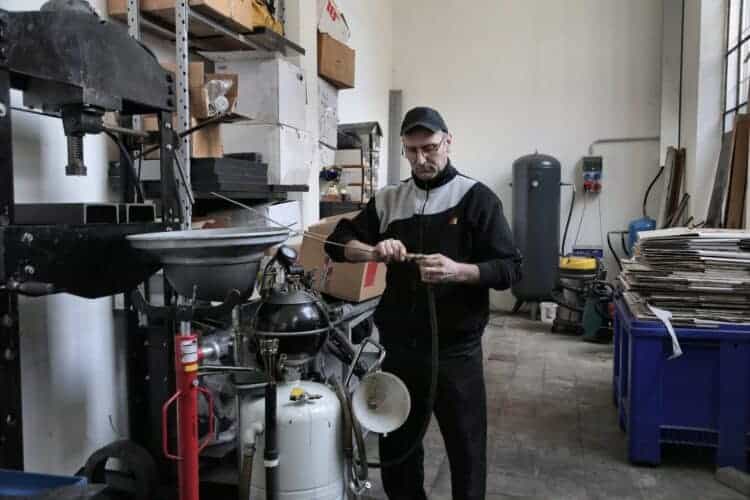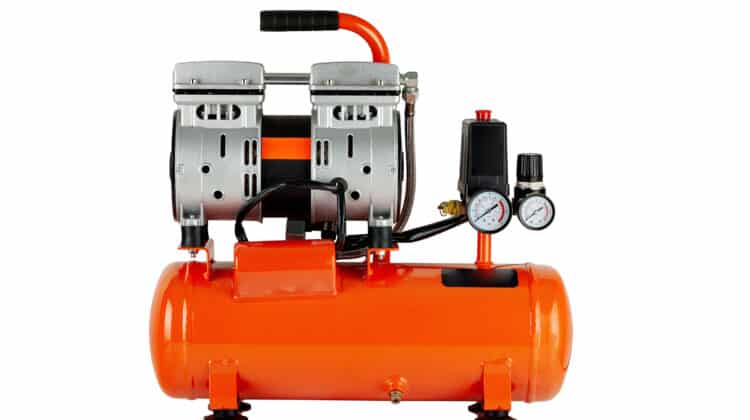
Learning how to increase CFM on air compressor is not a particularly difficult task. By following the steps in this article, you can safely adjust your compressed air unit’s CFM rating to fit your needs.
Table of Contents
What Does CFM Mean?
CFM is the shortened form of the term cubic feet per minute. It measures how fast air moves from the environment to fill the receiver tank of your compressed air unit.
Take a look at this example.
You have a compressed air unit rated at ten CFM. That means that your equipment will deliver ten cubic feet of air in a minute.
When calculating the CFM of your compressed air unit, there are two things you want to keep in mind.
The first is the size of the air receiver tank. The second is how fast your pump works.
The tank of your air tool must match the CFM of your compressed air unit. All figures need to align with the task you want to complete and how much pressurized air it will take.
This is the best way to ensure your compressed air unit and air-powered tools are efficient. And using them that way gets rid of any additional work.
But, sometimes, it is okay to use DIY hacks to do the job when our machines fall short. There are several reasons why you may have to increase the CFM on your unit. And we want to take a close look at how you can do that.
What Is The Relationship Between CFM And PSI?
Another term we need to get used to in this article is PSI, which means pounds per square inch. It measures how much pressure is in the receiver tank of your compressed air unit. Most air-powered tools use are PSI rated between forty and ninety.
So the CFM measures the volume of air. The PSI measures the pressure of the air. Together, these figures will give you all the information you need to know about the capacity and capability of compressed air units.
How To Increase CFM On Air Compressor
Here, we will begin showing you how to increase CFM on air compressor units. There are several ways that you can do that.
- lowering the pressure in order to boost CFM
- Adding a second compressor with the same CFM rating
- Connect two compressors with different CFMs together
- The addition of a second air receiver tank
- Increasing the present compressor’s capacity
Let’s take a close look at what each of these entails.
Lowering The Pressure To Boost CFM
Every compressed air unit comes with its power rating, which you get when you multiply the CFM by the pressure. There is no way to change the power of your unit. You cannot adjust the CFM of the tank. What you can do is change the pressure.
How do you do that?
By lowering the pressure in the tank. Use the pressure regulator to drive down the PSI of your unit. The CFM of your unit will rise.
You do not need to worry about fluctuations in your power. It will remain constant.
A lot of people who use compressors are not aware that the Outlet CFM of their compressed air unit depends on their selected outlet pressure.
Below is an easy example of what I mean.
Let’s say you have a compressed air unit rated with a 4 CFM rating and 90 PSI. You can run an air-powered tool that demands five CFM of constant streaming pressurized air on about 50 PSI or less. You can even try to use an air tool with a CFM rating higher than five.
That’s because the relationship between the PSI and the CFM at the outlet of compressed air unit tanks is just about equal. There may sometimes be limitations to keep in mind. We will talk about those in the next segment.
So, watch out for your air tools CFM rating and the working pressure as well. Most times, they may have a working pressure that is lower than 90 PSI. This will allow you to get a quick CFM boost from the compressor that you have. You may not have to buy a new one to get the power you need.
Learn The Advantages Of Lowering The Pressure To Boost CFM
- Suitable for long-term air tool use. But this is only true if the compressor’s CFM is more than the tool’s CFM demand.
- Suitable for use with air tools on an intermittent basis.
- This option will cost you the least amount of money. All it takes is to make some minor changes to your compressed air unit. You can do this yourself.
Know The Disadvantages Of The Lower Pressure Method
- Your air-powered tools need to have a working pressure that is much less than 90 PSI.
Adding A Second Compressor With A CFM To Match The One You Own
You can double your current compressed air unit’s CFM rating by adding a second compressor to the system. Keep in mind that the added compressor should be the same model and brand as well. Doing so will eliminate any control complexity.
That’s because of the similar make, model, and brand of both pieces of equipment. The pressure switch on both will have the same cut in and out pressure set.
Using this method will boost the CFM of your compressed air unit’s pumping system. You will see the effects of this higher CFM output at the pressure regulator/tank outlet.
Once your second compressed air unit is in place, connect the two with an air hose. All you need is a tee fitting to join the two. Then plug the air-powered tool you want to use into the system.
These Are The Advantages Of Adding A Second Compressor
- With this method, the compressed air system will have a greater CFM, which is ideal for continuous air tool use.
- Also suitable for use with air tools on an intermittent basis.
Disadvantages of Using A Second Compressor
- Purchasing a second compressor will not be as cost-effective.
- Although pressure switches should be similar, there may be some differences. You have to make a few adjustments to match the cut-in and out pressures of both units.
- You still need to pay attention to both units’ duty cycles. That way you can match them with the CFM of your air-powered tools. Remember they need to complement each other.
If you do not need a continuous delivery of air at this CFM rating, then it is best to skip this method.
Connect Two Compressors With Different CFMs
This method is sort of like the one we did before. The main difference is that your compressors will not have the same CFM.
CFM and the other 5. If you connect the two of them, you will have a steady stream of air at a rate of 15 CFM.
Here is how you make the connection between the two.
- Use a tee fitting to make a connection between the tank outlets of each unit.
- Now connect the air hose of your compressed air unit with the tee-fitting outlet.
- Connect your air-powered tool to the air hose and you are ready to go.
Advantages Of Connecting Compressed Air Units Of Different CFM Value
- With two compressed air unit, you pressurized air system will have a higher CFM capacity. The pumping capability will supply your air-powered tools with a continuous stream of air.
- Suitable for use with air tools on an intermittent basis.
Disadvantages Of Connect Of Different CFM Value
- You will need another air compressor which will cost some money if you do not already have one. You could always borrow another unit if you only need it for temporary use.
- You will need to use adjustable compressed air unit pressure switches.
- You also still need to pay attention to your unit’s duty cycle. That way you can ensure the tool you want to operate is compatible with it.
How Can You Control The Cut-in Of Two Air Compressors With Different Specs?
It can be difficult to operate two compressed air units with varied sizes, power, and CFM. Even different pressure levels can be tricky to manage. Each unit’s pressure switches are likely programmed to cut in when they reach different levels.
The compressors you connect now share the same storage volume. But the cut-in trigger of each unit has not changed.
So what happens if one of your connected units has a PSI of 80 and the second has a 90 PSI? The cut-in with the higher PSI value will only kick in when the system dips under 80 PSI. That cut-in will happen while the 90 PSI compressed air unit still runs.
How To Do A Pressure Switch Adjustment
To make the necessary pressure switch adjustment, you must keep in mind that you have two machines working with. If they have the same cut-in/out points, they will work about the same but that also depends on what your air tools demand.
but, a too large gap between the cut-in/out points of the two compressors will overwork one system. You will have to do more maintenance and in the end, it will lead to a shorter lifespan for your compressor.
The CFM you want to get will also be smaller. That’s because you can only reach peak CFM when:
- The air in the receiver tank is at 99% capacity.
- The pumps of both compressed air units are working right before the cut-out point kicks in.
- If your setup is 99% capacity and the compressor with the higher CFM value is running. At this stage, the system will respond to the peak CFM capacity of the compressor with this value.
But, in cases where the system is at 99% capacity and both your compressed air units are running, the CFM will match the value of your full setup.
Adding A Second Receiver Tank
I think this is one of the simplest ways to adjust the CFM on your compressed air unit.
By adding a second receiver tank, your compressed air unit will supply both tanks with air. You have a lot more air storage. This means the motor on your air compressor has to run longer before hitting the cutout point. It allows you to keep using your air-powered tools for longer periods.
Because you have more storage capacity, your CFM automatically increases. But, keep in mind that the increased storage adjusts the CFM available for a time. It does not change the system’s CFM. When you remove the extra tank, your compressed air unit will have its original CFM value.
Things To Consider When Adding A Second Tank To Compressed Air Units.
This method is easy. And I would not say there are advantages and disadvantages. So, there are just a few things I want to mention that you need to keep in mind.
- Using your air-powered tools continuously is not the best idea. That’s because your compressor always has to play catch up, which is not good for your system.
- Ideal for using air tools on an intermittent basis (compressor gets given a chance to cool).
- Ideal for using air tools on an intermittent basis (compressor gets given a chance to cool).
- It’s cost-effective because you will only need to buy another tank. You do not need a new compressed air unit.
- Even for occasional usage, you have to get the tank sizing right. So you will need to do some research into compressed air unit sizing.
Remember to design this system so that it supports the specs of the air-powered tools you plan to run on it. Pay attention to the duty cycle.
Increase The Capacity Of Your Compressed Air Unit
When we talk about increasing the capacity of your compressed air unit, we mean the motor and the pump.
Increasing the pump on a compressor can make available the CFM rating you need. And you can use it whenever you need to. But if you increase the size of the pump, you also need to up the size of the motor. That’s because the motor size and pump size of compressed air units must match each other.
Things To Consider When Expanding The Size Of Your Compressed Air Unit
Depending on the age and size of your tank, retrofitting a new compressor pump and motor to an existing tank may be cost-effective. But, it may still make more economic sense to invest in a new system with the CFM rating you want.
How To Increase CFM On Air Compressor – Summary
There is one thing you need to remember when following our how to increase CFM on air compressor article. The CFM on air-powered tools is not all the same. Some will need more. Others will need less.
Always ensure that you match the specs on your compressed air unit with the specs of your air tools.





